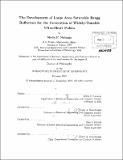The development of large area saturable Bragg reflectors for the generation of widely-tunable ultra-short pulses
Author(s)
Nabanja, Sheila P
DownloadFull printable version (26.53Mb)
Other Contributors
Massachusetts Institute of Technology. Dept. of Electrical Engineering and Computer Science.
Advisor
Leslie A. Kolodziejski and Gale S. Petrich.
Terms of use
Metadata
Show full item recordAbstract
This thesis focuses on the realization of two photonic devices; 1) semiconductor lasers and 2) large area broadband Saturable Bragg Reflectors (SBRs). Semiconductor lasers explore the use of 3D and 2D quantum confinement of charge carriers within quantum dots (QD) and quantum wells (QW) lasers respectively. The index-guided QD and QW heterostructure lasers that were fabricated in this work investigate the electrical and optical properties of these active regions for the implementation in all-optical logic gates. Saturable Bragg Reflectors (SBRs) can be used for the generation of widely tunable ultra-short pulses for various laser systems. The III-V based SBRs comprise of layers, whose thicknesses correspond to the wavelength of the laser system that is to be mode-locked. To form short pulses, SBRs with broadband reflectivity and large area (hundreds of microns) are required. One of the key elements for the realization of broadband SBRs is the development of the thermal oxidation process that creates buried low index AlOY layers over large areas. The design, fabrication, characterization and implementation of ultra-broadband high index contrast III-V/AlOy SBRs as circular mesas, as well as inverted mesa structures for ultrashort pulse generation is presented using a physical model of the oxidation process.
Description
Thesis (Ph. D.)--Massachusetts Institute of Technology, Dept. of Electrical Engineering and Computer Science, 2012. Cataloged from PDF version of thesis. Includes bibliographical references (p. 166-172).
Date issued
2012Department
Massachusetts Institute of Technology. Department of Electrical Engineering and Computer SciencePublisher
Massachusetts Institute of Technology
Keywords
Electrical Engineering and Computer Science.